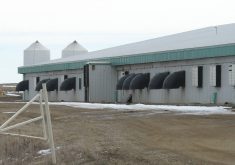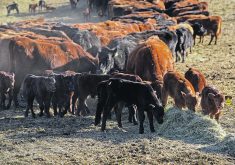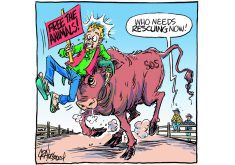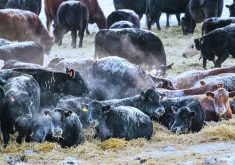The bacterium Mycoplasma creates a wide spectrum of symptoms in cattle.
In feedlot animals, it attacks the lungs, causing pneumonia, and commonly spreads to the joints, inducing arthritis. In dairy cattle it causes pneumonia but also diarrhea and mastitis, as well as middle ear infections in calves.
Cattle transmit Mycoplasma through respiratory secretions. An infected animal exhales the bacterium and the next host inhales it or licks it up from a contaminated surface. Once established in the upper respiratory tract, Mycoplasma organisms travel into the lungs where they cause small areas of dead cell nodules called necrosis. The damage is so extensive in some animals that it triggers fatal pneumonia.
Read Also

Good handling equipment a must on cattle operations
It’s important for the safety of producers and everyone else dealing with their stock that handling equipment is functional and safe.
Mycoplasma is more likely to cause disease in a feedlot animal that has an impaired immune system, such as one infected with bovine viral diarrhea virus. A normal animal with a healthy immune response is able to ward off Mycoplasma organisms.
Once settled in the lungs, Mycoplasma can move to other sites by travelling through the blood stream. It has a predilection for joints, and usually settles in multiple joints in each individual.
Researchers at the veterinary college in Saskatoon have found that about 10 percent of animals with Mycoplasma pneumonia also have Mycoplasma arthritis. The stifle, or knee of the back leg, is the most common joint infected, or at least the place the infection can be found.
Researchers also confirmed that at least 95 percent of cattle with Mycoplasma arthritis had some degree of pneumonia, which supports the premise that Mycoplasma starts in the lungs and spreads to the joints.
Feedlot animals that have both a lung and joint Mycoplasma infection breathe heavier and faster than their pen mates and are lame. If the animals don’t die, they will likely do poorly and won’t respond to antibiotics. Most of them are shipped to cut losses.
A University of Guelph Animal Health Laboratory newsletter described a devastating Mycoplasma outbreak in a 50-cow dairy herd in which about 20 milk cows developed pneumonia. They experienced respiratory distress, low-grade fevers and lack of appetite. Half of the affected cows also had diarrhea and three got mastitis.
By the end of the 10-day outbreak, five cows died, one was sent to slaughter and two were killed because they didn’t respond to treatment. The source of the infection was traced to a bull that had been introduced to the herd a month before the outbreak. The bull had pneumonia, and because it didn’t respond to antibiotics, had been sent to slaughter.
Another outbreak occurred in dairy calves that were fed Mycoplasma-contaminated milk. The infected calves developed severe infections of the middle ear and the area behind their eardrums filled with cheesy-looking material. The calves were depressed and not eating, had droopy ears and head tilts. Some died.
The Mycoplasma bacterium entered the calves’ ears through the little tube that connects the mouth to the middle ear or through the blood stream.
No matter where Mycoplasma settles in the body, its presence is difficult to diagnose. A post-mortem examination is the only reliable form of detection.
Unfortunately, it is often too late to treat and save herd members by the time the first animal has died and been examined.
This means veterinarians have to think of the disease when prescribing antibiotics. Many animals can be saved if the right antibiotic is started early enough in the course of the disease.
As more veterinarians become aware of this devastating disease, the success rate in treatment will rise.














